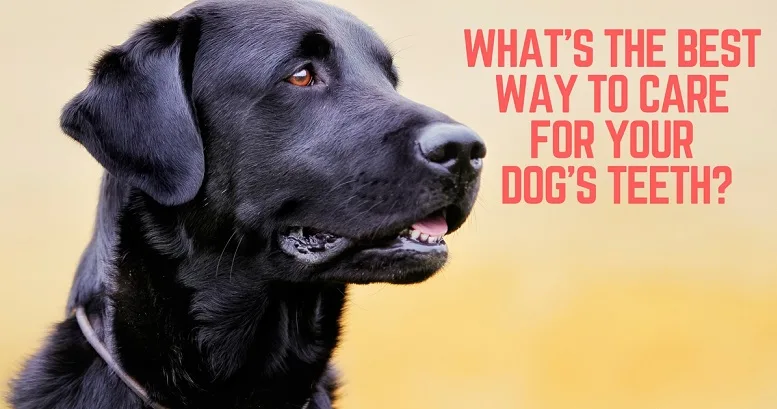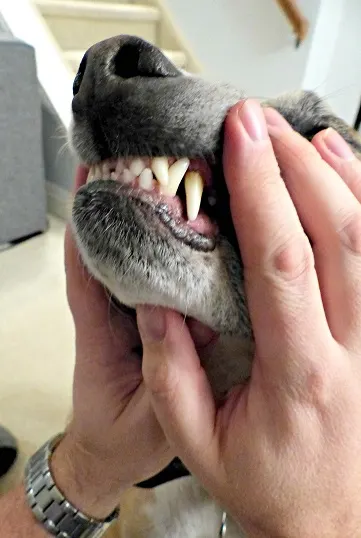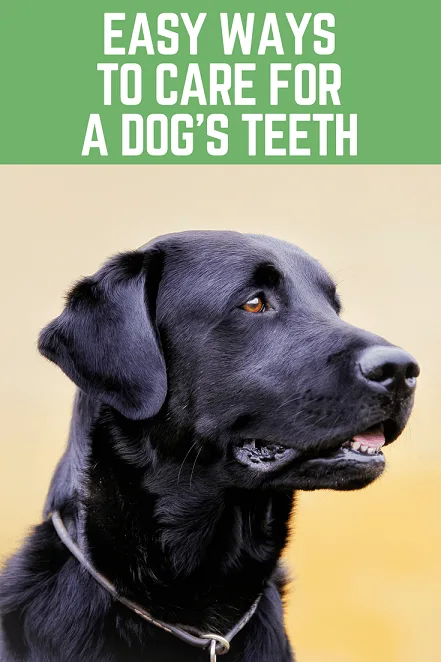One of my resolutions this year is to do a better job taking care of Baxter’s teeth.
February’s Pet Dental Month is the perfect excuse to investigate doggie dental care more closely and get a better understanding of why it’s so important.
A long-time friend of mine, Laurie Stevenson, is a registered veterinary technician at our clinic, Clappison Animal Hospital.
Below, she and my favorite vet, Dr. Stephen Longridge, explain how to take care of your dog’s oral health.
Laurie Stevenson and Dr. Stephen Longridge: As with people, dental health care is a key element in the overall well-being of our pets. A diseased mouth can lead to disease in other areas of the animal’s body.
A healthy mouth enables the animal to eat a healthy diet free of pain, prevents infection from entering the blood stream and can prolong your pet’s life. It’s about both the quality and length of your pet’s life.
JT: What can you tell from looking at a dog’s mouth?
LS & Dr. SL: When examining an animal’s mouth we are looking at the teeth, gums, lips, tongue—everything in the mouth. We also take note of areas surrounding the oral cavity including the eyes.
We note the colour and wear of the teeth and gums, any abnormal pigmentation, gum erosion, and tartar or calculus (the really hard debris on an animal’s teeth) build up.
Also, we can tell what the animal has been chewing and whether or not they chew more on one side than the other. If one side is used more it may indicate areas of pain or teeth that are loose.
JT: What are common issues you see?
LS & Dr. SL: Loose teeth due to gum recession are very common. Deep pockets around the teeth (gum recession) allow bacteria to grow which in turn leads to infection around the tooth as well as pain and inflammation. The roots of the teeth can become exposed leading to pain, infection and loose teeth. The jaw bone can actually begin to erode due to infection.
JT: Why is it important to get regular checkups that include dental checks?
LS & Dr. SL: If problems are caught before they get too bad then the animal’s teeth can be saved and money can be saved as well. It’s much better (and cheaper) to prevent problems than it is to fix them once they have occurred.
If dental disease progresses too far, it can lead to more severe diseases, in turn leading to a shorter overall lifespan.
JT: How does tooth care prevent other diseases?
LS & Dr. SL: A diseased mouth allows infection to enter the animal’s blood stream and harm organs. Usually, bacteria do not lead to infection or abscesses in other organs, but they create constant wear and tear on the body.
In some cases bacteria may enter the animal’s blood stream causing a systemic infection. This infection can enter other organs causing heart, kidney or liver failure.

JT: What’s the best way to take care of your dog’s teeth?
LS & Dr. SL: The best way to take care of your dog’s teeth (and cat) is to brush daily. This can be very difficult of course, so as much brushing as possible is best.
If you cannot brush on a daily basis, the next best thing is to use chew treats such as CET chews which are specifically made to rub against the pet’s teeth as they chew and thus get rid of tartar.
These chews also contain an enzyme which mixes with the dog’s saliva and aids in killing the bacteria in the mouth which causes tartar.
A specific dental diet may also be a good choice. The kibbles are formulated to brush up against the animal’s teeth which chewing. They are also larger kibbles and need to be chewed more than normal kibbles
Finally, additives can be added to your dog’s drinking water. They are similar to mouthwash for humans and aid in killing bacteria.
All these methods can be undertaken to prevent tartar build up which in turn leads to calculus.
JT: What’s involved in a professional dental cleaning?
LS & Dr. SL: A professional dental cleaning is very similar to human dental cleaning. The biggest difference for animals is that they must be under general anesthetic.
The animal is sedated, placed on IV fluids, then put under general anesthetic. A technician begins by cracking off the large pieces of calculus. The teeth are thoroughly examined on all sides and each tooth is individually charted.
Defects such as cavities, fractures, pulp exposure, wearing are all noted. The gums are examined around each tooth for deep pockets where infections start. The entire mouth is examined in detail.
Next an ultrasonic scaler is used to remove all calculus and tartar from the exposed parts of the teeth. Any loose teeth or teeth with exposed roots and bifurcations are noted. A curette is used to clean beneath the gums to remove tartar from under the gum line.

Next the veterinarian examines the mouth and determines if any teeth need to be removed. X-rays may be taken—to be sure of tooth health full mouth dental x-rays should be taken. It is impossible to see what is going on underneath the gums otherwise and problems may go undetected.
The vet will then extract any teeth using elevators. This is the most time consuming part of the dental procedure. Any lumps or abnormal tissue growth are also removed at this time.
For large teeth that are removed the gums will be sutured together to aid in healing. An oral rinse helps clean the mouth and kill bacteria. If many teeth are removed the pet may be placed on antibiotics for a time after the procedure.
Once all the extractions are completed and the teeth have been cleaned (scaled), the teeth are polished. Once this has been done the animal is cleaned up and the mouth is rinsed.
The pet is now woken up and recovered before going home at the end of the day.
JT: What’s the most important thing people should realize about dental care for their dogs?
LS & Dr. SL: No matter the breed or diet, each and every dog should have their teeth closely monitored and properly taken care of. Brushing is the best way! Dental care is not just for humans. A healthy mouth means a healthy pet overall and can help them lead a longer and happier life with fewer health issues.
As for the rest of you …
Do the rest of you get regular dental check-ups? How do you take care of your dog’s teeth?
Let us know in the comments!
Related article: Can’t afford a dental cleaning for my dog

Julia Thomson is a regular writer for That Mutt. Visit her blog Home on 129 Acres where she writes about her adventures of country living and DIY renovating.
Related posts:
Alternatives to brushing a dog’s teeth
How to get a dog used to nail trims (similar approach could be used for teeth brushing)
Cleaning your dog’s teeth without anesthesia
I can’t afford a dental cleaning for my dog

Scott
Thursday 16th of February 2017
go with raw bones - 3-4 a week will give them massive pleasure, good nutrition, and will clean teeth in pretty thorough way!
sandy weinstein
Wednesday 15th of February 2017
I go to a dental specialist that is over 180 miles away several times a year. he started the dental program at NCSU vet school. people come from all over the us, Canada to visit him. my youngest, had problems which my former vet did not do anything abt or tell me. i went to her with problems when my girls was not even a yr old. she had been seeing this dog since she was a puppy. one of her front teeth was loose. she wanted to pull over 10 teeth. I was pissed especially since I have the paperwork that stated that her teeth looked great. you can not tell from just looking at the teeth if their is a problem. Dr. Banker, was very upset since this was one of his former students. he did gum graphs and root planning, and only pulled 2 back teeth. he said even xrays don't tell the entire story, you have to get in and look at the teeth. he worked with a human dentist yrs ago and developed his own line which can be purchased on line. he demands that you brush you dogs' teeth everyday if not twice a day. we go for checkups every few months. he does not do the regular anesthesia, he puts the dogs in lala land, then uses nitrate oxide, which means a dog can be brought out of it right away unlike the injectable kind. he does just enough to get the dog to go under, he uses a warming blanket as well, and then observe the dogs afterwards. he will not let any dogs go home while still showing any results from anesthesia. they do not put the dogs in the back, they keep them in the hallway behind the rooms so they can watch them. he is so reasonable, infact, after he did the surgery and cleaning on my first dog, I asked if the bill was correct b/c it was the same as a regular cleaning I had paid for at my old vet who had screwed up. they had even given one of my dogs so much anesthesia it took her 2-3 days to come out of it, I took her back twice and they did nothing. Dr. Banker even will call you at home. he called me twice at home when my oldest dog was having a few issues. he uses different types of anesthesia depending on the age, size, breed and health issues. he has a wonderful staff. I brush the girl's teeth with a baby toothbrush. I use a dental flosser on my of my dogs, I have even used dental floss as well. then I use his dental gel that helps with the gums. he states no pulling, no hard chews, no hard toys, no rope toys with pulling, these are all bad for your dogs teeth. just like with humans you cant pull on your teeth, you loosen the teeth in the gum line. no tennis balls because they wear down the enamel of the teeth. especially with small dogs no bones, no hard chews, no antlers even for big dogs. my regular vet got flooded with calls after xmas last yr because people had given their dogs the antlers, many had cracked their teeth. the rule of thumb I have gone by is that if you can not make a dent in the treat or chew with your fingernail, then it is too hard for your dog to eat. the line of dental products he recommends are the Oxyfresh dental get and original toothpaste, the human kind because it does not have the other stuff in it, it is a whitening toothpaste, safe for dogs, he also recommends TDC periodontal &joint health for dogs and cats, it is a soft capsule that you open and wipe on the gum lines.
Julia at Home on 129 Acres
Wednesday 15th of February 2017
Wow. Thanks for all of the detail. It sounds like you're very conscientious and on top of your dental care.
Keith Amdur
Wednesday 15th of February 2017
Oh boy Emma Lou is 3 1/2 and I have the finger tooth brushes,the long tooth brushes,dog toothpaste and I do not brush her teeth(dumb).My vet. said that the tennis balls (which she loves more then life)are grinding her teeth down.I try other balls but she only plays with tennis balls.The balls act like sandpaper on her teeth.From this day forward I WILL BRUSH HER TEETH every day.I got to find a way to make it fun....anybody??.Thanks Lindsay,have a update or follow up on this subject to make sure I am doing what I should have been doing all along.
Julia at Home on 129 Acres
Wednesday 15th of February 2017
Don't despair! You're definitely not the only person to struggle with tooth care. As much as I've resolved to do better this year, I still haven't successfully established a routine that works for us. I'm not sure it will ever be fun. I'll just be happy when it's routine!
Lindsay Stordahl
Tuesday 14th of February 2017
Also, I am curious if those "dental formulated" lines of dry dog and cat food actually work. I have heard that is a myth, that kibble does nothing to clean their teeth and actually can make the teeth worse. However, I asked my dog's vet about it and he said the kinds specially formulated for cleaning the teeth can actually help, assuming the pet actually chews the food. (One of my cats is food obsessed and also my weim, they just swallow their food!)
I'm curious what others know about the dental formulated dry food.
Barbara Rivers
Wednesday 15th of February 2017
Missy & Buzz brush their own teeth with raw meaty bones they get several times per week. It totally works - Dr. Ian Billinghurst's "Give Your Dog A Bone" is a wonderful book that explains the how's & why's.
According to him, kibble is the opposite of healthy food and causes more harm than good. I will say that I fed both of my pups kibble for the first 3.5 years of their lives before making the switch to raw food. Missy's teeth were still clean, but her brother Buzz's teeth started showing signs of tartar, so he got a professional dental cleaning (yikes, expensive).
I think it may depend on a dog's chewing habits and maybe also their genetical predisposition to cleaner teeth? Who knows. The one thing I can attest to is the power of raw meaty bones and a raw, balanced diet after feeding it for almost 2 years now ;-)
Julia at Home on 129 Acres
Tuesday 14th of February 2017
That's the thing with Baxter too. He swallows pretty much everything whole. Even looking for dental chews (sticks or treats) was challenging because as soon as he chomps something into chunks, he swallows the pieces whole--even ones that seem big enough to choke him. The fact that your vet makes the same recommendation as our vet makes me feel like there must be some truth to the dental kibbles.
Lindsay
Tuesday 14th of February 2017
I said when I get a new dog I would brush his teeth every day. Here I am, I've had Remy almost a year and I have not brushed his teeth once. I tell myself it's just not worth it! He's so wiggly, he bites and paws. I haven't even attempted it. I'd like to hear if others brush their dogs' teeth. How's it going with Baxter?
Julia at Home on 129 Acres
Tuesday 14th of February 2017
It's going, but I'm definitely not as consistent as I'd like to be. I've heard it takes 30 days to form a new habit? I just need to stick with it!